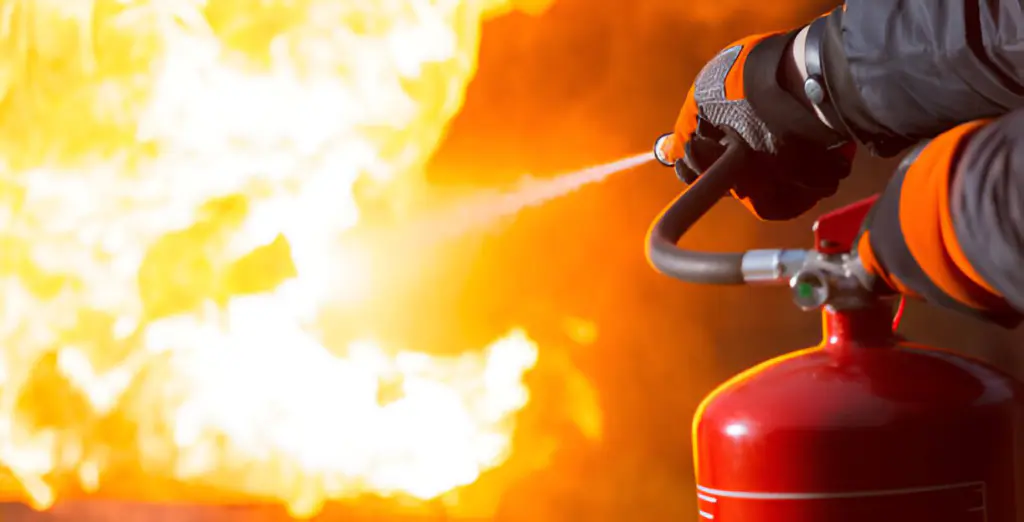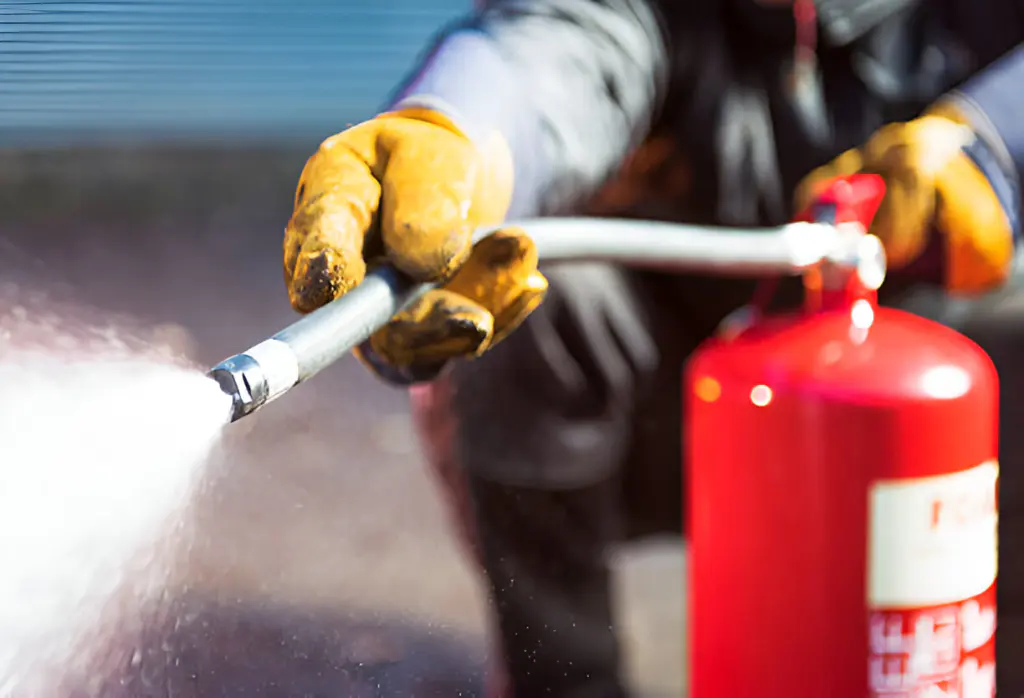In fire safety, selecting the right gas for extinguishers is essential, and tailored to specific applications and fire classes. Carbon dioxide and nitrogen are popular choices, providing powerful fire suppression without leaving harmful residues. Let’s explore Which Gas Used in Fire Extinguisher.
This version is concise, highlighting the importance and effectiveness of the gases used while making it attractive for readers. However, the introduction of newer halocarbon agents, which are less harmful to the environment, presents a dilemma regarding efficiency versus environmental impact. This raises a pertinent question: with advancements in technology and increased environmental awareness, what is the future of gas selection for fire extinguishers, and how might it evolve to meet both safety and ecological standards?
Key Takeaways
- Carbon dioxide (CO2) is used in fire extinguishers for electrical and Class B fires.
- Nitrogen is employed primarily to reduce oxygen levels in fire suppression systems.
- Halocarbons like FM-200 disrupt the combustion process by absorbing heat.
- Dry chemical extinguishers often contain monoammonium phosphate for Class A, B, and C fires.
- Water and foam extinguishers utilize air-pressurized water or foam for Class A and B fires.
Which gas is used in fire
In fire suppression systems, various gases are employed, each selected for its specific properties and effectiveness in extinguishing flames. The choice of gas is critical, as it directly influences the safety, efficiency, and environmental impact of the fire suppression process. Gases like carbon dioxide, nitrogen, and halocarbons have distinct characteristics that make them suitable for different fire scenarios.

Carbon dioxide (CO2) is a popular choice due to its ability to suffocate fire by displacing oxygen in the environment. It is non-conductive, making it ideal for electrical fires, and it leaves no residue, thus minimizing damage to equipment. However, it can be hazardous to humans at high concentrations.
Nitrogen, another inert gas, works similarly by reducing the oxygen level around the fire. It is safer for occupied spaces as it supports a breathable atmosphere when used in appropriate concentrations.
Halocarbons, which include agents like FM-200 and NOVEC 1230, extinguish fire primarily through heat absorption and chemical reactions that interrupt the combustion process. These gases are favored for their low toxicity and environmental friendliness, presenting minimal ozone depletion potential and global warming impact.
Each gas’s properties must be carefully evaluated against the specific requirements of the protected area to ensure optimal fire suppression while maintaining safety standards.
what are the 4 types of fire extinguishers?
While there are several types of fire extinguishers available, four main categories are commonly recognized: water, foam, dry chemicals, and carbon dioxide. Each type is suited for different fire classes, which are categorized based on the materials fueling the fire.
Water extinguishers are effective against Class A fires, which involve ordinary combustibles such as wood, paper, and cloth. They function by cooling the burning material, but are not suitable for grease, oil, or electrical fires.
Foam extinguishers are versatile, used primarily for Class A and B fires, which include flammable liquids. They extinguish flames by forming a barrier between the fuel and the air.
Dry chemical extinguishers are prevalent due to their effectiveness on Class A, B, and C fires, which involve electrical equipment. They operate by interrupting the chemical reaction at the fire’s core.
Carbon dioxide extinguishers are ideal for Class B and C fires. They extinguish the fire by displacing oxygen and cooling the fuel.
Regular extinguisher maintenance is crucial to ensure functionality in emergency scenarios. This involves routine checks for physical damage, proper pressure levels, and obstructions in the nozzle or hose, adhering to safety standards and technical accuracy for operational readiness.
Which gas is used in fire extinguishers in London
Safety across London’s diverse environments dictates the use of various gases in fire extinguishers, tailored to specific fire classes. In the bustling cityscape, adherence to London fire safety norms and extinguisher regulations is paramount.

Carbon dioxide (CO2) is prevalently employed in Class B and electrical fires due to its non-damaging and non-conductive properties, making it ideal for offices filled with electronic equipment. For kitchens and restaurants, where grease and oil fires are common, wet chemical extinguishers are preferred. These extinguishers utilize potassium acetate-based agents that effectively smother the flames.
In industrial areas, dry chemical extinguishers, containing monoammonium phosphate, are widely used for their versatility in tackling Class A, B, and C fires. Such robust solutions are critical for ensuring safety in factories and warehouses with complex fire risks.
Furthermore, clean agent extinguishers, such as those containing halocarbons, are chosen in environments like museums and art galleries to protect valuable items from fire damage while minimizing residue.
Each selection is guided by rigorous assessments of potential fire types and the substances present, ensuring that every extinguisher deployed across London not only meets legal requirements but also upholds the highest standards of fire safety and effectiveness.
How to use a fire extinguisher
Understanding the types of gases used in fire extinguishers across London sets the foundation for effectively deploying these devices in emergencies. Mastery of fire safety and extinguisher maintenance can significantly enhance the effectiveness of your response in a crisis. When using a fire extinguisher, it is crucial to follow the PASS technique: Pull, Aim, Squeeze, and Sweep.
| Step | Action | Detail |
|---|---|---|
| Pull | Pull the pin. | This will break the tamper seal. |
| Aim | Aim low. | Point the extinguisher nozzle at the base of the fire. |
| Squeeze | Squeeze the handle. | This releases the extinguishing agent. |
| Sweep | Sweep from side to side. | Move the nozzle or hose across the base of the fire until it is extinguished. |
| Check | Check if the fire re-ignites. | Repeat the process if necessary. |
Each type of extinguisher is suited for different classes of fires, and selecting the right one is critical to effectively tackling the fire without causing further hazards. Regular training and drills should incorporate not only the mechanical aspects of operating an extinguisher but also a deep understanding of its maintenance and limitations. Always ensure that the fire extinguisher is easily accessible, properly charged, and within the expiry date to guarantee functionality when required.
CO2 Fire Extinguisher
CO2 fire extinguishers, containing non-flammable carbon dioxide gas, are highly effective for extinguishing electrical fires and those involving flammable liquids, classified as Class B and C fires. The principal mechanism by which CO2 extinguishers operate is by displacing oxygen in the environment surrounding the fire, thereby suffocating it.
Carbon dioxide, being heavier than air, blankets the fire and prevents further oxygen from feeding it, which quickly suppresses the flame.
One of the significant CO2 advantages is that it leaves behind no residue, making it an ideal choice for use in environments where contamination from other extinguishing agents (such as dry chemicals) could be problematic, such as in data centers, telecommunication facilities, and laboratories.
Additionally, CO2 is non-conductive, ensuring safety when deployed on electrical fires.
CO2 applications extend beyond just firefighting. Due to its properties, it is also used in fire training exercises and in systems designed for automatic fire protection in areas where traditional water-based systems could cause damage to assets, such as in archival storages or museums.
However, it is crucial to note that CO2 can pose risks of asphyxiation when used in confined spaces, necessitating proper ventilation and safety measures during its deployment.
Conclusion
In conclusion, fire extinguishers employ various gases such as carbon dioxide, nitrogen, and halocarbon agents, each selected based on the specific fire class they are most effective against. Carbon dioxide extinguishers are prevalent for Class B and C fires, especially in environments like data centers where residue is a concern. Nitrogen is utilized to safely lower oxygen levels, while halocarbon agents provide heat absorption and combustion interruption, offering a balance between efficacy, safety, and environmental considerations.









